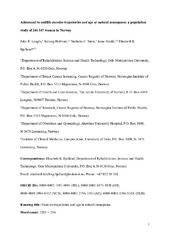Adolescence to Midlife Exercise Trajectories and Age at Natural Menopause: A Population Study of 246 147 Women in Norway
Permanent lenke
https://hdl.handle.net/10037/37995Dato
2025-05-02Type
Journal articleTidsskriftartikkel
Peer reviewed
Forfatter
Langås, Julie Røgler; Hofvind, Solveig Sand-Hanssen; Støer, Nathalie Charlotte; Eskild, Anne; Bjelland, Elisabeth KreftingSammendrag
Design - Retrospective population-based cohort study.
Setting - Self-administered questionnaires in the Norwegian breast cancer screening program (BreastScreen Norway) during the years 2005–2016.
Population - A total of 246 147 women, aged 50–69 years.
Methods - We used latent class mixed model analyses to identify distinct exercise trajectories from adolescence to midlife. The associations were estimated as hazard ratios using Cox proportional hazard models. Adjustments were made for year and country of birth, educational level, number of childbirths, smoking habits and body mass index. We identified four adolescence to midlife exercise trajectories: high (reference), increasing, decreasing and low exercise levels.
Main Outcome Measure - Age at natural menopause.
Results - The adjusted hazard ratio of reaching menopause was highest for women with constantly low exercise levels as compared to women with constantly high exercise levels (adjusted hazard ratio 1.06, 95% CI: 1.05–1.07). Also, decreasing and increasing exercise levels were associated with higher hazards of reaching menopause (adjusted hazard ratios 1.02; 95% CI: 1.01–1.04 and 1.02; 95% CI: 1.00–1.03, respectively).
Conclusions - Women with low exercise levels from adolescence to midlife had the earliest menopause, and women with high exercise levels had the latest. However, the associations were weak, suggesting little influence of exercise on the large variation in age at menopause.


 English
English norsk
norsk